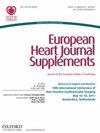Immediate, short-term, and long-term effects of balloon mitral valvuloplasty on the left atrial global longitudinal strain and its correlation to the outcomes in patients with severe rheumatic mitral stenosis
IF 1.7
4区 医学
Q3 CARDIAC & CARDIOVASCULAR SYSTEMS
引用次数: 0
Abstract
Abstract Background Global longitudinal left atrial strain (GLS) has been used as a new assessment tool for left atrial function. Aim To investigate the effect of balloon mitral valvuloplasty (BMV) in patients with severe rheumatic mitral stenosis on GLS and its relation to the mitral valve area achieved after the procedure. Methods The study included 95 patients with severe mitral stenosis who fulfilled the criteria for BMV (case group) and 80 normal healthy subjects (control group). All included participants underwent complete echocardiographic examinations. For the case group, GLS was assessed by 2D speckle-tracking Echocardiography before valvuloplasty, immediately after, within 24 h, at 6 months, and at 12 months, and the results were compared. Results The impaired left-atrium strain in patients with severe mitral stenosis was improved immediately after BMV, and the improvement continued at 6 and 12 months post-BMV (23.1% ± 4.2 vs. 36.0 % ± 4.9, 36.2% ± 4.5, and 40.1% ± 9.5, respectively P < 0.01). After BMV, there was a significant decrease in left atrial volume (76.3 ± 12.4 mL/m2 vs. 68.6 ± 10.4 mL/m2, P < 0.01) and a significant increase in the area occupied by the mitral valve (1.02 ± 0.18 cm2 vs. 1.60 ± 0.31 cm, P < 0.01).The immediate GLS and the mitral valve area were positively correlated (r = 0.64, P < 0.01). Furthermore, the immediate GLS was associated with significantly improved function class (P < 0.01). Conclusion GLS can indicate left atrial function (mainly reservoir function). The improvement observed in patients after BMV may indicate that GLS can be used to evaluate the progress after BMV. Additional Content An author video to accompany this abstract is available on https://academic.oup.com/eurheartjsupp. Please click on the arrow next to ‘More Content’ and then click on ‘Author videos’.球囊二尖瓣成形术对严重风湿性二尖瓣狭窄患者左心房总纵应变的即时、短期和长期影响及其与预后的相关性
背景全局纵向左心房应变(GLS)是一种评价左心房功能的新方法。目的探讨重度风湿性二尖瓣狭窄患者球囊二尖瓣成形术(BMV)对GLS的影响及其与术后二尖瓣面积的关系。方法选取符合BMV标准的重度二尖瓣狭窄患者95例(病例组)和正常健康者80例(对照组)。所有纳入的参与者都进行了完整的超声心动图检查。对于病例组,在瓣膜成形术前、术后立即、24小时内、6个月和12个月时通过二维斑点跟踪超声心动图评估GLS,并对结果进行比较。结果重度二尖瓣狭窄患者左心房应变受损在BMV后立即得到改善,并在BMV后6个月和12个月持续改善(分别为23.1%±4.2∶36.0%±4.9、36.2%±4.5和40.1%±9.5);0.01)。BMV后左房容积显著降低(76.3±12.4 mL/m2 vs. 68.6±10.4 mL/m2), P <0.01),二尖瓣占用面积显著增加(1.02±0.18 cm2 vs. 1.60±0.31 cm, P <0.01)。即时GLS与二尖瓣面积呈正相关(r = 0.64, P <0.01)。此外,即时GLS与显著改善的功能等级(P <0.01)。结论GLS能反映左心房功能(主要是左心房储血功能)。患者在BMV后观察到的改善可能表明GLS可用于评估BMV后的进展。一个作者的视频,伴随着这个摘要可在https://academic.oup.com/eurheartjsupp。请点击“更多内容”旁边的箭头,然后点击“作者视频”。
本文章由计算机程序翻译,如有差异,请以英文原文为准。
求助全文
约1分钟内获得全文
求助全文
来源期刊

European Heart Journal Supplements
医学-心血管系统
CiteScore
3.00
自引率
0.00%
发文量
575
审稿时长
12 months
期刊介绍:
The European Heart Journal Supplements (EHJs) is a long standing member of the ESC Journal Family that serves as a publication medium for supplemental issues of the flagship European Heart Journal. Traditionally EHJs published a broad range of articles from symposia to special issues on specific topics of interest.
The Editor-in-Chief, Professor Roberto Ferrari, together with his team of eminent Associate Editors: Professor Francisco Fernández-Avilés, Professors Jeroen Bax, Michael Böhm, Frank Ruschitzka, and Thomas Lüscher from the European Heart Journal, has implemented a change of focus for the journal. This entirely refreshed version of the European Heart Journal Supplements now bears the subtitle the Heart of the Matter to give recognition to the focus the journal now has.
The EHJs – the Heart of the Matter intends to offer a dedicated, scientific space for the ESC, Institutions, National and Affiliate Societies, Associations, Working Groups and Councils to disseminate their important successes globally.
 求助内容:
求助内容: 应助结果提醒方式:
应助结果提醒方式:


